
Tsunami Devastates American Samoa
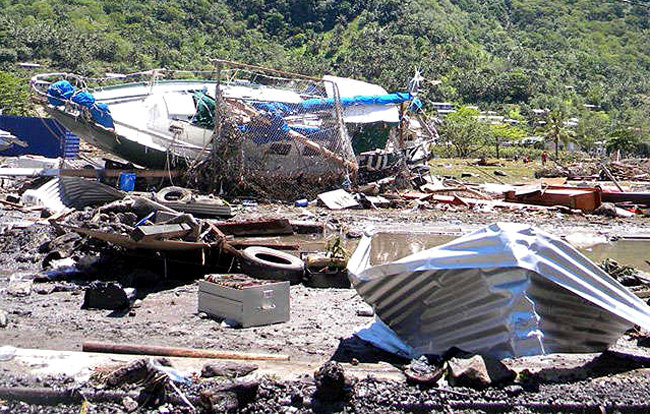
Yesterday at 6:48 a.m. local time, an 8.0-magnitude earthquake shook awake American and Western Samoa. Several minutes later — just enough time to allow folks to make their way outside to talk with their neighbors about the temblor — a tsunami swept the islands, killing at least 119 people.
Aussie singlehander Nick Jaffe of the Contessa 26 Constellation — who was featured in the July issue of Latitude — is in Apia on Western Samoa. He reports that "the marina and Apia Harbor began to dry as the water went out to sea. Several boats in the marina hit the ground but I don’t think there was any damage. I went to Aggie Grey’s hotel until things calmed down."
John Neal and Amanda Swan-Neal of the Friday Harbor-based Hallberg Rassey 46 Mahina Tiare were also in Apia when the tsunami hit. "Amanda and I were on our morning run when the street started shaking," said John. "Minutes after we arrived back at the harbor, the civil defense sirens went off and the police directed everyone to run for the hills. The water in the marina started to really surge, dropping lower after each surge in. We followed the moving mass of people, cars and trucks up the hills. The smart yachties headed for Aggie Grey’s hotel, where staff welcomed them and sent them to the top floors. They had a great view of the harbor going dry for several hundred yards out."
About 300 miles south, in the Vava’u group of Tonga, Eric and Emmy Willbur of the Pt. Richmond-based Flying Dutchman 37 Nataraja said that their anchorage of Kenutu saw some "rather interesting tidal flows with 3- to 4-ft standing waves breaking over the reef. There were reports of major tidal influences at other anchorages with water going out suddenly and dropping as much as 10 feet, then coming back in very quickly. Here in Vava’u, we’ve only heard of small docks being washed away — no loss of life or major damage."
David Tyler and Fran Flutter of the UK-based Tystie, who were featured in February’s Latitude when they passed through the Bay, were in nearby Neiafu Harbor and report experiencing a rise and fall of just a couple feet. "No damage apart from some jetties being washed away," they said.
By far the most comprehensive report came from Puddle Jumper Kirk McGeorge, who is cruising with his wife Catherine and their five-year-old son Stuart aboard the USVI-based Hylas 47 Gallivanter. McGeorge called us via Skype from Pago Pago on American Samoa shortly after the tsunami devastated the island, then sent the following report:
"This morning we were shaken awake by an earthquake which seemed to have no end. We were aboard Gallivanter and side-tied to a big concrete dock. After the rude awakening, Cath and I walked across the dock to chat with a few of our fellow sailors, one of whom said that he’s just done a Google search on ‘recent earthquakes’ and said that it measured in at 8.1 and the epicenter was only 120 miles southwest of Pago Pago on the southern side of the island.
"We returned to Gallivanter and I verified what he said. Just as I was considering the ramifications of that little fact, all hell broke loose. Our boat was on the move! I started the engine and dashed up on deck to see what was going on. I witnessed the water around us rapidly dropping — rapidly! In the blink of an eye, we were on the bottom and the boat was falling away from the dock. Three of our big docklines popped and we fell right over into the mud — the entire basin in which we had been floating only moments ago had completely drained! People were screaming!
"The water came flooding back in at an even more alarming rate, and the next thing I knew we were floating directly above the dock. We were over the concrete slab and drifting toward a young lady we knew from another boat, who was up to her chin in swirling water and desperately hugging a power pole. I told Cath to cut the two remaining dock lines with our serrated bread knife and to be quick about it!
"Right as I put the boat into gear, we were somehow washed back off the dock and into the basin as I advanced to full throttle. We accelerated through a floating debris field of floating docks, fuel drums, sinking boats, a shipping container and a barnacle-encrusted wreck, all of which were spinning in the torrent of rapidly dropping sea level. It was absolute mayhem! As we steered out toward the deep water in the center of the harbor, I looked over my shouder and saw what appeared to be a waterfall pouring off the dock and shore beyond. Not one of the dozen vessels remained at the dock. All were underway in a matter of seconds — with or without crews aboard.
"We motored around in the middle of the harbor watching the waves of floods and ebbs while wondering about aftershocks and our fellow cruising sailors. As we passed one of our neighbors, she shouted to us that her husband had been washed off the dock as they were trying to get away. She was alone and seriously concerned. We found out later that he was confirmed dead. Other boats broke free from their moorings and anchors in the initial seismic waves, and many were driven ashore or driven under by loose tuna boats.
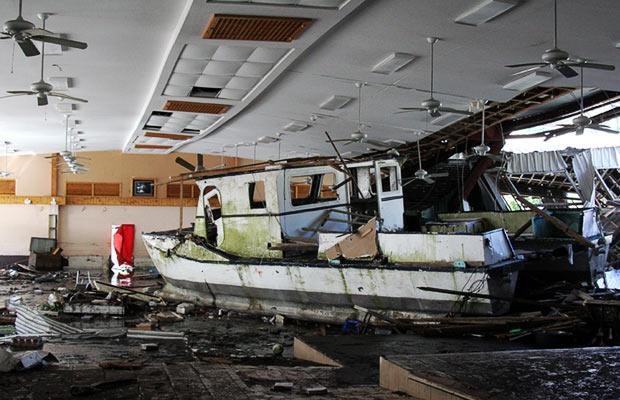
"After about three hours, we felt it was finally safe to return to the dock. We were the first to go back in so we started untangling lines and helping others get back alongside the concrete dock. All the storefronts along the water are destroyed, roving mobs of kids can be seen looting, the fence around the dock is gone, and every boat on stands in a nearby boatyard was washed away. Big fishing boats are now in parking lots across the street. Absolute destruction is seen everywhere along the shore.
"Phones and power are down but we got back online right away. I immediately went back to the recent earthquakes website to see if things had calmed down in the center of the earth. A number of aftershocks as strong as 6.0 were recorded over the following few hours — but thankfully no more wave action has been noticed. We’ve been making Skype calls to our families and letting others use the computer as well to phone home.
"Online news reports say that the earthquake lasted three minutes and the highest flood rose 25 feet above normal! Most fatalities occured in and around the harbor where we live. Boats are battered and nerves are fried. One friend wound up on his boat nearly 1,000 feet inland after breaking from his anchor and sailing right down Main Street, taking power and telephone wires down with his mast! Some people lost everything, including their lives. We came through remarkably well with only minor damage sustained to our toerail when the docklines parted and to our fender basket, which was the only point of contact with a drifting wreck. I believe our hull, keel and rudder suffered no damage from the wildest boat ride I’ve ever been on. We’re all okay — and very lucky."
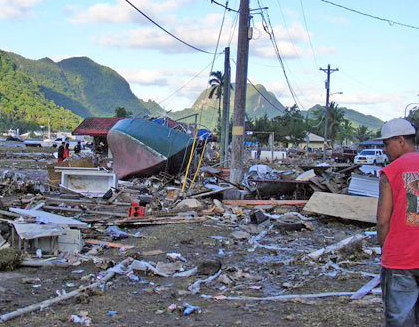
This morning, a 7.6-magnitude quake hit Sumatra, Indonesia — along the same fault line that spawned the devastating 2004 quake that left 232,000 dead. Though more than 1,000 are feared dead, and thousands more are caught in the rubble, a tsunami warning has been lifted.
Who Needs a Hot Tub?
Who needs a hot tub when you have a dinghy and a hose? Veteran of the ’07 Ha-Ha (now in La Paz), Anthony Diliberti of the Seattle-based Ta Chou 55 Mandalay says it’s impertive to chill the beer first!
Online Puddle Jump Rally Sign-Up
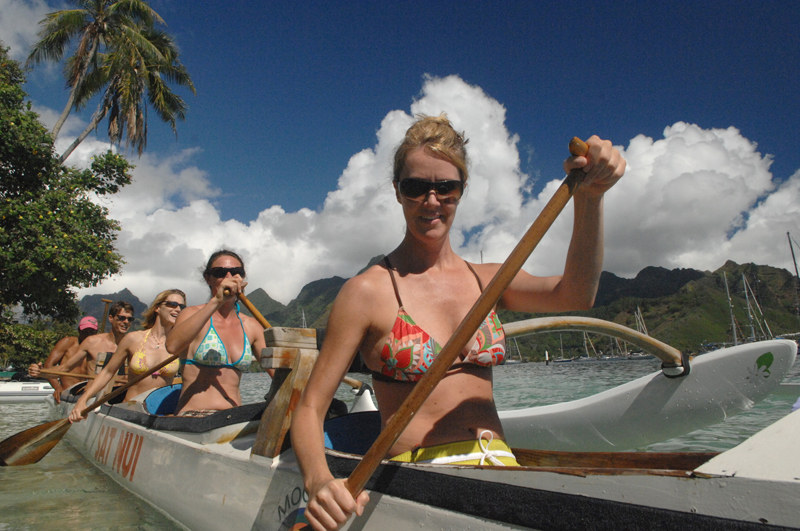
Although the prime window for crossing from the Americas to French Polynesia is still five months away, many cruisers are already gearing up for that ambitious 3,000-mile passage.
If you are one of them, you’ll want to officially register with this year’s rally by filling out our short questionnaire online. It’s free, and doing so will get you an invitation to the free, three-day Tahiti-Moorea Sailing Rendezvous, June 18-20. And with any luck you’ll also be offered a special clearance bond exemption — a potential savings of roughly $1,500 per crew member.
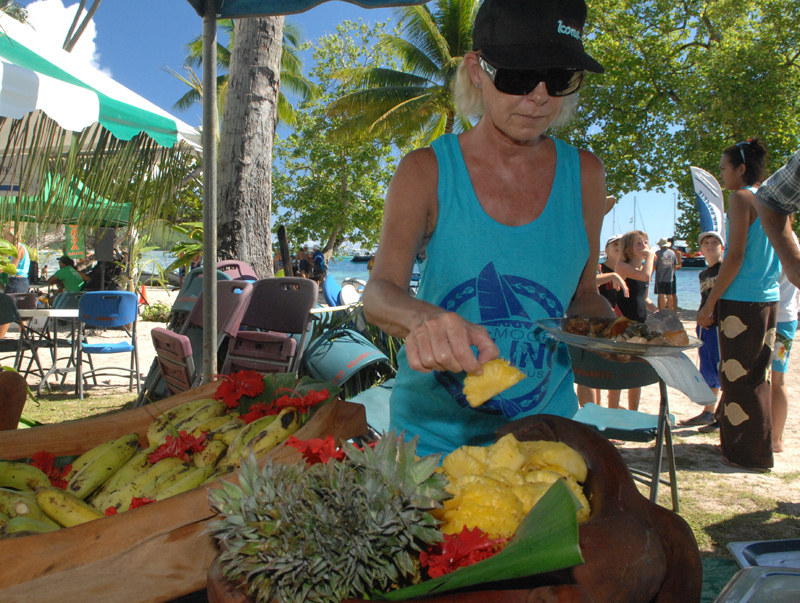
We should clarify that the Pacific Puddle Jump is a rally only in the loosest sense of the word, as boats depart at different times from many ports along the west coast of the Americas. Along the way, though, many share info via radio nets on weather, inter-island cruising and a variety of other topics. A few years ago we helped our Tahitian partners create the Rendezvous as a ‘back-end’ celebration, where many members of the fleet meet for the first time. It’s now become a much-anticipated annual event.
You can learn more about the Puddle Jump at the website, where many articles on previous fleets can be downloaded for free in PDF format.
Be aware also, that we will be holding a free Puddle Jump seminar at 5 p.m., Saturday, October 24, at the San Diego West Marine (1250 Rosecrans).
